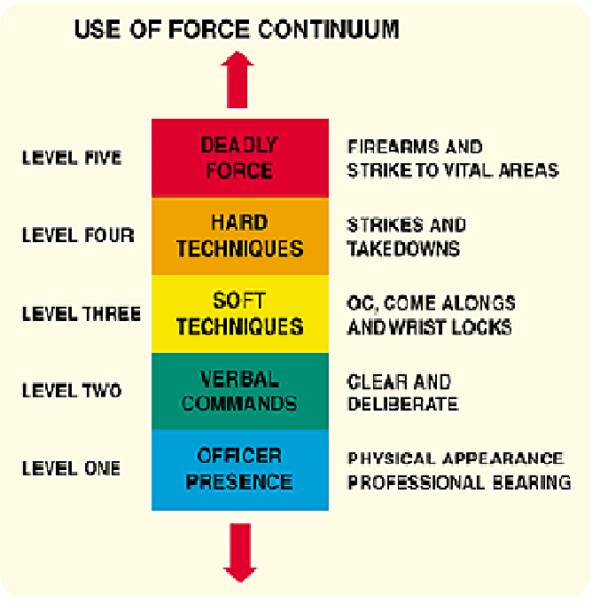The De-Escalation and the Use of Force
The application of force is a topic covered throughout a police officer’s career. Training begins academically at the academy, followed by practical “defensive tactics” and similar training. Recruits and candidates are instructed ontechniques and their appropriate applications. However, as officers, we do not live in a text book, and anyone who has ever worked on the street can tell you that situations develop faster than most can recall data. It is important to highlight that knowledge and skill of this arena are not solely gained at the academy. There are many training programs, as well as books and authors on the topic which help prepare an officer for his/her tasks.There are many situations in a police officer’s responsibilities that call for the responding officer to enter a situation low, and escalate as necessary. For example, a domestic disturbance where a husband and wife are verbally arguing might not be best solved by walking in and shouting. If we walk in and begin to yell, where do we go from there? A little verbal judo here might de-escalate the situation.
Another topic to begin this article that must be discussed is the difference between affecting an arrest of a resisting suspect, and an attack on a police officer. The easiest way to break this down is to ask the following: Is he trying to get away, or is he trying to attack me? In the first, your force must be directed to affect an arrest without injury to self, other officers, or innocent parties. In the latter, you must save yourself. You must go home at the end of the shift. You must win. You must counter attack. Now how much force is reasonable?
In attempting to affect an arrest, the textbook answer would be the amount necessary to get the job done. End of story. But how much force is reasonable when the resistor turns on you. How much is necessary when the suspect takes that swing, that kick, draws the weapon, or goes for yours?
This is not the time to decide if you have the capability in you to cause serious bodily harm. That decision should be burned into your mind from the moment you took that job. At the moment you feel threatened, at the moment you feel the reality set in, you have to already be engaged in battle. The appropriate response is to be in “kill or be killed” mode, and begin your attack with the initial intent to take it to the end if necessary. Here is where the title of this article “de-escalation of force” comes into play.In verbal judo, we enter low and steady and calm. At this point, we can work up to where we need to be. When your life is on the line, you must begin the fight at the top level. You must be in kill mode and give nothing less than all the fight you have in you. As I say this, you might be thinking that you cannot, or that it is wrong to feel this way. But remember that we are all animals, and possess instincts and capacity beyond education. And also remember that this may be the call, this may be the fight that stops you from going home at the end of your shift. The one that gets your family a folded flag.While applying all of the necessary physical, mechanical, or ultimately lethal force during this encounter, the situation may change. As this dynamic situation unfolds, the suspect may fight on, surrender, or be rendered incapable of fighting further. At this point, you may de-escalate if necessary, and keep the situation in the physical force/mechanical force sector. But the mental preparedness to exert lethal force must always be there, ready to emerge from your primitive brain without conscious decision. You must fight with everything you have, until you know that you are safe.
A good parallel to this is Firearm Training System (FATS) type interactive training. A scenario may present an armed suspect (shoot), who moments later drops the weapon (don’t shoot). Specifics change, and we must change with them. But one thing that remains the same, is that we must be mentally prepared to go as far as necessary to protect ourselves, or brother/sister officers, and the public.
This article proposes the polar opposite in handling physical attackvs. many other types of disturbances. It is important to mentally prepare for your job every day, and unfortunately in our chosen career, you must mentally prepare to kill someone every single day.
*It should be noted that the ideas in this article are that of the author, and do not represent explanation or interpretation of law (state or federal). All information is for informative purposes only, and students should seek legal guidance from their agency, legal advisor, or classroom instructor regarding the application of force.
_________________
The Author Benjamin Campos is a NJ Law Enforcement Officer
PTC Certified Firearms Instructor
PTC Certified Recruit Instructor
Use of Force / Weapon Applications
NRA Training Counselor
He can be reached for instruction HERE http://www.ShootSmartTraining.com
![]()


